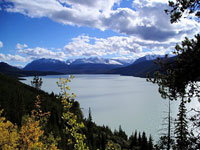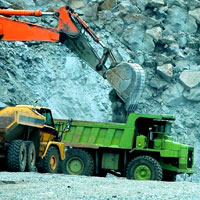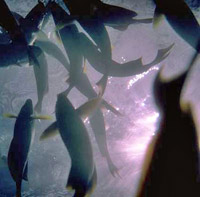
News |
- Court Challenge to Stop Arctic Drilling
- Interfaith Call for Climate Action
- Brokenhead Ecological Reserve Wetland Trail
- Nebraska Forces Obama's Hand on Pipeline
- Lake St. Martin Channel Operational
- Cuts Could Hamper Environmental Assessment
- Comment Period Extended for Caribou Recovery Strategy
- Taseko At It Again! Fish Lake Once Again At Risk
- Crowd of 28,000 Aim to Stop Mega Quarry
- Canadians Demand Canada Go Beyond Coal
- Department of Fisheries to be Gutted
- Mining Déjà Vu for KI First Nation
| Court Challenge to Stop Arctic Drilling | 10 November 11 |
 The Obama administration has lifted a moratorium on offshore drilling in the Arctic and elsewhere, and Royal Dutch Shell has received preliminary permits to drill exploratory wells off the coast of Alaska. Shell wants to drill up to three exploratory wells in the Chukchi Sea and two in the Beaufort Sea in 2012.
The Obama administration has lifted a moratorium on offshore drilling in the Arctic and elsewhere, and Royal Dutch Shell has received preliminary permits to drill exploratory wells off the coast of Alaska. Shell wants to drill up to three exploratory wells in the Chukchi Sea and two in the Beaufort Sea in 2012."Allowing Shell to drill when it has no credible plan to cleanup an oil spill in the Arctic's icy waters, and instead simply assumes it can clean up 95 percent of oil spilled isn't just unrealistic, it's insulting and irresponsible," said Earthjustice attorney Holly Harris. Earthjustice, on behalf of the Native Village of Point Hope, , Greenpeace, Natural Resources Defense Council, Oceana, Pacific Environment, Sierra Club, and seven other environmental organizations initiated litigation in the United States Ninth Circuit Court of Appeals September 29th, 2011 challenging the US Bureau of Ocean Energy Management, Regulation, and Enforcement (BOEMRE) decision to allow oil drilling in the Beaufort Sea. "Approving Shell drilling in the Beaufort Sea is irresponsible and risks disaster. We have a right to life, to physical integrity, to security, and the right to enjoy the benefits of our culture. For this, we will fight, and this is why we have gone to court today," said Caroline Cannon, President of the Native Village of Point Hope. View September 29th, 2011 Earth Justice press releaseView September 29th, 2011 United States Ninth Circuit Court of Appeals Petition for Review View September 29, 2011 Fuel Fix article View October 25, 2011 New York Times article View November 3, 2011 U.S. News article View November 4, 2011 Associated Press article View Nov/Dec Natural Resources Defense Council Newsletter Nature's Voice View Natural Resources Defense Council The Arctic National Wildlife Refuge: Policy Reports and Analyses page Source:
Earth Justice
|
|
 Print version Print version |
Top |
| Interfaith Call for Climate Action | 10 November 11 |
 At an historic meeting in Ottawa, October 23rd and 24th, faith leaders, politicians and members of the public gathered to engage in a dialogue about climate change. Participants discussed climate change as the root of a spiritual crisis, the values necessary for a sustainable economy, and the challenge of climate justice.
At an historic meeting in Ottawa, October 23rd and 24th, faith leaders, politicians and members of the public gathered to engage in a dialogue about climate change. Participants discussed climate change as the root of a spiritual crisis, the values necessary for a sustainable economy, and the challenge of climate justice.A joint statement "Canadian Interfaith Call for Leadership and Action on Climate Change" was developed in advance of the 17th Conference of the Parties to the UN Framework Convention on Climate Change, to be held in Durban, South Africa, November 29th to December 9, 2011. "We call for leadership to put the long-term interest of humanity and the planet ahead of short-term economic and national concerns. The teachings of our faiths tell us that the best interests of one group or nation are served by pursuing the best interests of all people. There is one human family and one Earth that is our common homeland. Climate change is a global crisis and requires global solutions that put the well-being of all people first - especially the most vulnerable," reads the joint statement signed by nearly 30 religious leaders and representatives of faith based organizations across Canada. View October 25, 2011 Canadian Interfaith joint statement (PDF)View October 25, 2011 Council of Canadian Churches press release View October 25, 2011 Citizens for Public Justice article (PDF) View November 4, 2011 North American Interfaith Network article View November 7, 2011 Embassy Magazine article View Manitoba Wildlands COP17 page Source:
Council of Canadian Churches
|
|
 Print version Print version |
Top |
| Brokenhead Ecological Reserve Wetland Trail | 10 November 11 |
 The Manitoba Government announced a new $1-million interpretive trail and boardwalk next to Brokenhead Wetland Ecological Reserve October 24, 2011.
The Manitoba Government announced a new $1-million interpretive trail and boardwalk next to Brokenhead Wetland Ecological Reserve October 24, 2011.The Brokenhead Wetland Ecological Reserve was established in 2004. The 563-hectare parcel of land is located 70km north of Winnipeg near the southeast corner of Lake Winnipeg and Brokenhead Ojibway First Nation. The Brokenhead wetland is a calcareous fen, a wetland type considered rare in North America. The ecological reserve features 23 species of provincially rare and uncommon plants, 28 of 36 native orchid species including the ram's head lady's slipper (Cypripedium arietinum) and eight of Manitoba's 10 species of carnivorous plants. Eugene Reimer, a long-time naturalist, photographer, and board member of Native Orchid Conservation Inc., donated $600,000 to the Winnipeg Foundation to establish the Eugene Reimer Environment Fund, which will provide an annual grant to the Brokenhead Wetland Interpretive Trail. "It brings me great joy and satisfaction to make a contribution towards protecting these wetlands where I spent so many happy hours enjoying and learning about nature," said Reimer. Construction of the Brokenhead Wetland Interpretive Trail will begin in 2012 and take approximately two years to complete. View October 27, 2011 Selkirk Journal articleView October 25, 2011 Winnipeg Free Press article View October 24, 2011 Government of Manitoba news release View October 24, 2011 Debwendon Inc. Brokenhead Wetlands Ecological Reserve Announcement page View Orchid Conservation Coalition, Brokenhead Wetland Interpretive Trail page View Native Orchid Conservation Inc., Conservation Prospectus for the Brokenhead Wetland Ecological Reserve Source:
Government of Manitoba
|
|
 Print version Print version |
Top |
| Nebraska Forces Obama's Hand on Pipeline | 4 November 11 |
 Opposition continues to grow against the $7 billion TransCanada Keystone XL pipeline, which would bring crude bitumen from Alberta's massive oil sands projects to Gulf Coast refineries in United States (US).
Opposition continues to grow against the $7 billion TransCanada Keystone XL pipeline, which would bring crude bitumen from Alberta's massive oil sands projects to Gulf Coast refineries in United States (US).On November 6, 2011 an estimated 5,000 pipeline opponents are expected to arrive in Washington D.C. to encircle the White House, demanding that President Obama say no to the pipeline. Hollywood actor Robert Redford has lent his name to the cause in a recent online video. Nebraskan legislators remain undeterred in their opposition to the pipeline after being offered a $100 million performance bond and other oil spill protection measures from TransCanada. Many Nebraskans fear the pipeline, which would run through Nebraska, could threaten aquifers. Republican Governor of Nebraska Dave Heineman has convened a special session of the state's legislature to consider imposing restrictions on the route of the pipeline. The US State Department is slated to decide on the controversial project by the end of 2011, but many feel the State Department in biased in favour of the pipeline. The US Environmental Protection Agency has repeatedly challenged the State Department's environmental evaluation of the pipeline. These criticisms have been buoyed by revelations the company who provided the Keystone XL environmental impact assessment (EIA) has financial connections with TransCanada Pipelines. In a November 2, 2011 television interview with Omaha's KETV President Obama strongly suggested he will make the decision about the Keystone XL oil sands pipeline. This is a sharp change from the President's previous statements that the decision rested with the State Department. View November 2, 2011 Common Dreams articleView November 2, 2011 KETV Omaha article View October 24, 2011 Office of the Nebraska Governor media release View October 19, 2011 Inside Climate News View October 18, 2011 Reuters article View Natural Resources Defense Council Stop The Pipeline page View November 2, 2011 CTV News article Source:
Inside Climate News, Common Dreams
|
|
 Print version Print version |
Top |
| Lake St. Martin Channel Operational | 4 November 11 |
 Water began flowing November 1, 2011 through a $100 million dollar 6.5 kilometre (4 mile) channel intended to move water from Lake Manitoba to Lake Winnipeg.
Water began flowing November 1, 2011 through a $100 million dollar 6.5 kilometre (4 mile) channel intended to move water from Lake Manitoba to Lake Winnipeg.The channel drains water from Lake St. Martin through the new channel to the Dauphin River and into Lake Winnipeg. This will allow the Fairford control structure, which drains water from Lake Manitoba to Lake St. Martin, to run at full capacity over winter. The channel, constructed in just over two-months, was built on a temporary emergency basis. The project was exempted from environmental review under the Canadian Environmental Assessment Act and Manitoba's Environment Act. It is hoped the channel will prevent further Lake Manitoba flooding in 2012, after severe spring and summer flooding in 2011. Manitoba struggled to contain the swollen Assiniboine River by operating the Portage Diversion, which funnels water from the Assiniboine River into Lake Manitoba, operating well over its capacity for weeks in 2011. (The Portage Diversion is over 40 years old, and required emergency adjustments spring 2011.) That pushed water levels up on Lake Manitoba, and some 2,000 people were forced from their homes on the shores of Lake St. Martin and Lake Manitoba. Many are still waiting to return home. Hundreds of residents from the Lake St. Martin First Nation are still under an evacuation order as officials look to move the reserve permanently to a new location on higher ground. View November 2, 2011 Interlake Spectator articleView November 1, 2011 Government of Manitoba release View November 1, 2011 Government of Manitoba Lake St. Martin Emergency Channel Update View November 1, 2011 Winnipeg Free Press article View November 1, 2011 Winnipeg Sun article View August 23, 2011 First Perspective article (PDF) View August 5, 2011 Lake St. Martin Outlet Channel Authorization Regulation View Manitoba Wildlands Water Projects & Licensing page Source:
Government of Manitoba, Winnipeg Sun, Winnipeg Free Press
|
|
 Print version Print version |
Top |
| Cuts Could Hamper Environmental Assessment | 4 November 11 |
 Elaine Feldman, President of the Canadian Environmental Assessment Agency (CEAA) was before Canada's Parliamentary Standing Committee on Environment and Sustainable Development as part of CEAA's seven-year review, October 20, 2011.
Elaine Feldman, President of the Canadian Environmental Assessment Agency (CEAA) was before Canada's Parliamentary Standing Committee on Environment and Sustainable Development as part of CEAA's seven-year review, October 20, 2011.Feldman told members of a parliamentary committee that the agency could lose 43 per cent of its annual budget and may have to lay off one-third of its staff, at a time when the country is facing a huge surge in major projects in mining, oil and gas and forestry. "What I'm told is there is up to $500 billion of potential new investments in Canadian natural resource projects in the coming years, and if that is the right figure the agency is going to be very busy," said Feldman. The Canadian Environmental Assessment Agency reviews a wide range of projects that fall under federal jurisdiction, use federal money or take place on federal land. The projects include mining, hydro, oil and gas projects. The agency's mandate is to make sure that projects don't harm the environment. The federal government increased the agency's budget in 2007 and again in 2010 to help keep up with the surge in new applications for resource projects. But Feldman told the committee the money runs out at the end of this fiscal year. "Part of that funding does include money for aboriginal consultation," Feldman said, adding, "We don't know if the... funds will be renewed ... we will just have to wait and see." The Canadian Government has recently announced that it will no longer fund the Canadian Environmental Network, and will seek to cut more than 700 jobs at Environment Canada. Additionally in 2009 and 2010 the Canadian Environmental Assessment Agency Act was amended through the budgetary process, without the usual opportunities for public review. View October 27, 2011 Minutes of ProceedingsView October 20, 2011 Minutes of Evidence of Content View October 25, 2011 First Perspective article View October 20, 2011 CBC News article View October 20, 2011 iPolitics article View October 19, 2011 ABLawg.ca report Source:
Parliamentary Hansard, First Perspective, CBC News
|
|
 Print version Print version |
Top |
| Comment Period Extended for Caribou Recovery Strategy | 4 November 11 |
 The Government of Canada has extended the comment period on the proposed "Recovery Strategy for Woodland Caribou" for an additional 120 days.
The Government of Canada has extended the comment period on the proposed "Recovery Strategy for Woodland Caribou" for an additional 120 days.The recovery strategy, required under Canada's Species At Risk Act (SARA), was initially released August 26, 2011 - four years later than required under the SARA. The proposed recovery strategy faced immediate criticism. "This is not a recovery plan. This is barely a survival plan. The federal government is setting an insultingly low bar. Essentially any herd in serious decline is being written off. The bottom line is that this plan is illegal under SARA, as it defies scientific evidence on what caribou need to survive, nevermind actually recover," said Melissa Gorrie, Ecojustice staff lawyer. "By allowing 95 per cent of woodland caribou habitat in northeastern Alberta to be lost, the Government of Canada is proposing that Canadians 'write off' virtually all the habitat that supports Alberta's caribou herds in order to promote irresponsible levels of oilsands development," said Simon Dyer, Policy Director with the Pembina Institute. Canadian Parks and Wilderness Society (CPAWS) issued a report card on the recovery strategy in which they found that major improvements were required in 6 of the 8 categories examined. The deadline for comments has now been extended until February 22, 2012. View SARA Draft Recovery Strategy for Woodland CaribouView October 27, 2011 Yale Environment 360 report View October 17, 2011 Greenpeace blog post View October 17, 2011 CPAWS report (PDF) View August 26, 2011 Ecojustice media release Source:
Government of Canada, Ecojustice, Pembina Institute
|
|
 Print version Print version |
Top |
| Taseko At It Again! Fish Lake Once Again At Risk | 28 October 11 |
 Taseko Mines Ltd. has again submitted a revised proposal for the "New Prosperity Mine", and once again the proposal threatens Fish Lake in British Columbia's interior.
Taseko Mines Ltd. has again submitted a revised proposal for the "New Prosperity Mine", and once again the proposal threatens Fish Lake in British Columbia's interior.The Canadian federal government rejected Taseko's first proposal. Public and First Nations concerns over conversion Fish Lake into a mining tailings pond, and findings of an environmental review panel resulted in Environmental Affairs Minister Jim Prentice rejecting the project November 2, 2010. Minster Prentice described the panel report, as "scathing" and "the most condemning I have ever read." The review panel found that a Fish Lake mine would cause irreparable damage to both First Nations rights and the environment, including to fish stocks and grizzly populations. The company is back with a revised proposal. Fish Lake would be surrounded by the proposed open-pit mine and unusable for the life of the mine (up to 33 years). Over time, the water quality in Fish Lake would become "equivalent" to the water quality in the tailings facility, according to the company's own engineering expert. The nearby Xeni Gwet'in First Nation, member of Tsilhqot'in Nation, strongly opposes this mine and like before, have not been adequately consulted. "Why are we here again for the second time ... why can't we as first nations focus more on building partnerships with industry?" said Marilyn Baptiste, Chief of the Xeni Gwet'in First Nation. The Canadian Environmental Assessment Agency (CEAA) will decide whether to accept Taseko's revised project by November 7, 2011. View Sierra Club of British Columbia, New Fish Lake Proposal A Disaster websiteView October 25, 2011 Williams Lake Tribune article View October 19, 2011 Globe and Mail article View October 19, 2011 Vancouver Sun article View September 30th, 2011 West Coast Environmental Law article View August 2011, New Prosperity Gold-Copper Project Taseko Mines Ltd. (PDF) View July 2, 2010, Report of the Federal Review Panel: Prosperity Gold-Copper Mine Project Taseko Mines Ltd. British Columbia (PDF) View March 17, 2009, Project Information: Prosperity Gold-Copper Project, Government of British Columbia Visit Council of Canadians action page Visit Sierra Club BC's action page Visit MiningWatch Canada page View April 9, 2011 Manitoba Wildlands news item Source:
Sierra Club of British Columbia
|
|
 Print version Print version |
Top |
| Crowd of 28,000 Aim to Stop Mega Quarry | 28 October 11 |
 An estimated 28,000 people attended Foodstock. The October 16, 2011 pay-what-you-can festival raised more than $100,000 for the Stop the Mega Quarry Movement aimed at protecting nearby agricultural land and stopping the development of a quarry north east of Toronto.
An estimated 28,000 people attended Foodstock. The October 16, 2011 pay-what-you-can festival raised more than $100,000 for the Stop the Mega Quarry Movement aimed at protecting nearby agricultural land and stopping the development of a quarry north east of Toronto.In 2006, 8,000 acres of land was purchased by Highland Companies to start a large co-operative potato farm. In 2009, Highland Companies, announced a proposal for a quarry that would stretch over 2,300 acres in Melancthon Township, 110 km northeast of Toronto. The quarry would be deeper than Niagara Falls, and 600 million litres of water would be pumped out of the quarry every day. Thousands of 40-tonne trucks would travel on local roads, 24 hours a day. Local citizens are worried about the potentially devastating effects on the local community and environment. The mega-quarry proposal currently sits with the Ministry of Natural Resourcesí Aggregates Resources, the Ontario government department responsible for ensuring sustainable extraction of sand, gravel, and stone in the province. Ontario Minister of the Environment John Wilkinson ordered Highland Companies to undertake a comprehensive environmental assessment of the quarry proposal on September 1, 2011. A joint panel review by Ontario and Canada to assess environmental effects of the quarry application is being requested. View Stop The Mega Quarry websiteView October 17, 2011 Global News article View October 16, 2011 Toronto Star article View October 16, 2011 CTV News article View October 15, 2011 Globe and Mail article Watch October 20, 2011 video of concert opposing the quarry project Source:
Global News
|
|
 Print version Print version |
Top |
| Canadians Demand Canada Go Beyond Coal | 28 October 11 |
 Over 5,000 letters demanding stricter greenhouse gas regulations for coal power in Canada were submitted during the federal coal regulations public consultation period. . Climate Action Network Canada believes measures proposed in member submissions could insure that these regulations have a meaningful impact on Canada's path towards a safer, more sustainable future.
Over 5,000 letters demanding stricter greenhouse gas regulations for coal power in Canada were submitted during the federal coal regulations public consultation period. . Climate Action Network Canada believes measures proposed in member submissions could insure that these regulations have a meaningful impact on Canada's path towards a safer, more sustainable future.Leading Canadian organizations are concerned the proposed regulations will deliver only a 3% improvement towards meeting Canada's 2020 emissions target. Proposed regulations include a loophole that would allow the construction of a new Alberta coal plant by Maxim Power Corp. that then would not be subject to federal regulations until 2060. These regulations also allow coal power to play a role in Canada's electricity mix, which is inconsistent with the global need for emissions to peak between 2015 and 2020. "New dirty coal is unacceptable today, not after 2025," said John Bennett, Executive Director of Sierra Club Canada. "These regulations do very little to cut emissions, and keep coal powering electricity for the next 45 years." "If amended, these regulations have the potential to get us off coal and cut one tenth of Canada's emissions," said Graham Saul of Climate Action Network Canada. "Ontario phased out coal in under ten years - if they can do it, the rest of Canada can." "Coal powered England in the 1800s. It has no place in today's more enlightened world," said Dale Marshall, Climate Change Policy Analyst, David Suzuki Foundation. "It's time to move beyond coal. Canada can lead the world, but these regulations fall far short of what's needed." Visit Climate Action Network websiteView October 26, 2011 Pembina Institute article View October 25, 2011 World Wildlife Fund blog post Visit Stop Maxim Coal campaign page View Sierra Club Canada open letter Source:
WWF Canada, Pembina Institute, LeadNow, Sierra Club Canada
|
|
 Print version Print version |
Top |
| Department of Fisheries to be Gutted | 21 October 11 |
 A leaked Canada Department of Fisheries and Oceans (DFO) memo from assistant deputy ministers Siddika Mithani and David Balfour, to regional directors, says DFO will soon be significantly smaller, doing fewer things, with fewer employers, once the department completes a $56.8-million budget-cutting plan by 2014.
A leaked Canada Department of Fisheries and Oceans (DFO) memo from assistant deputy ministers Siddika Mithani and David Balfour, to regional directors, says DFO will soon be significantly smaller, doing fewer things, with fewer employers, once the department completes a $56.8-million budget-cutting plan by 2014.The documents do not include specific details on job losses. DFO, which has sustained repeated deep cuts to its science program over the last two decades, now must prepare for further cuts. The Fisheries Resource Conservation Council, an advisory body that collects the views of fishermen to help make better science decisions, has been disbanded, according to Newfoundland New Democrat Member of Parliament Ryan Cleary. "When you axe this, you take away a critical, a crucial voice for fishermen," said Cleary. It is unclear how DFO will fulfil its many legislative and regulatory obligations. The leaked memo follows on the heels of other recent announcements that the Canadian Government will not longer fund the Canadian Environmental Network, and will seek to cut more than 700 jobs at Environment Canada. View October 13 & October 17, 2011 CBC News articlesView October 13th, 2011 DFO Memo (PDF) View October 7, 2011 Postmedia article View October 4, 2011 Halifax Chronicle-Herald article View Fisheries Resource Council website View August 6, 2011 Manitoba Wildlands news item Source:
CBC News
|
|
 Print version Print version |
Top |
| Mining Déjà Vu for KI First Nation | 21 October 11 |
 The people of Kitchenuhmaykoosib Inninuwug (KI) First Nation Ontario are experiencing déjà vu, after a dispute over mineral exploration by God's Lake Resources (GLR) on KI's traditional lands. KI claims there may be sacred burial sites located on GLR's mineral exploration site.
The people of Kitchenuhmaykoosib Inninuwug (KI) First Nation Ontario are experiencing déjà vu, after a dispute over mineral exploration by God's Lake Resources (GLR) on KI's traditional lands. KI claims there may be sacred burial sites located on GLR's mineral exploration site.The dispute risks a repeat of the 2008 imprisonment of KI Chief Donny Morris and five other Council members, who were imprisoned for protesting mineral development and exploration on their traditional lands by Platinex Inc. "God's Lake recklessly and deliberately ignored our advice and entered the land," said KI Chief Donny Morris. KI issued a letter to Ontario Premier Dalton McGuinty, and an eviction notice to GLR at the end of September 2011. KI has asked the Ontario Government to suspend the project, apologize to the community, agree that no further work will be undertaken, and honour a 2008 promise by the McGuinty government to create a joint review panel to address consultation protocols in the region before issues get to the point of direct action. GLR has said it will ignore the eviction notice issued by KI, claiming requests to identify cultural sites have not been answered by KI, but agrees better consultation standards are required. "We recognize that KI and GLR may have one goal in common: Ontario First Nations and all claimholders in Ontario need to have guidelines that help us to interact respectfully," said Edward Ludwig, GLR President & CEO. View October 13th, 2011 Wawatay News articleView October 11th, 2011 Net News Ledger article View Kitchenuhmaykoosib Inninuwug (KI), Land & Environment Unit web page View KI Letters to Government and Press Releases View October 11th, 2011 First Perspective article View October 3, 2011 God's Lake Resources press release View Manitoba Wildlands Aboriginal Court Cases & Consultations page Source:
Wawatay News, KI website, Government of Ontario, God's Lake Resources
|
|
 Print version Print version |
Top |


 RSS Feeds:
RSS Feeds: